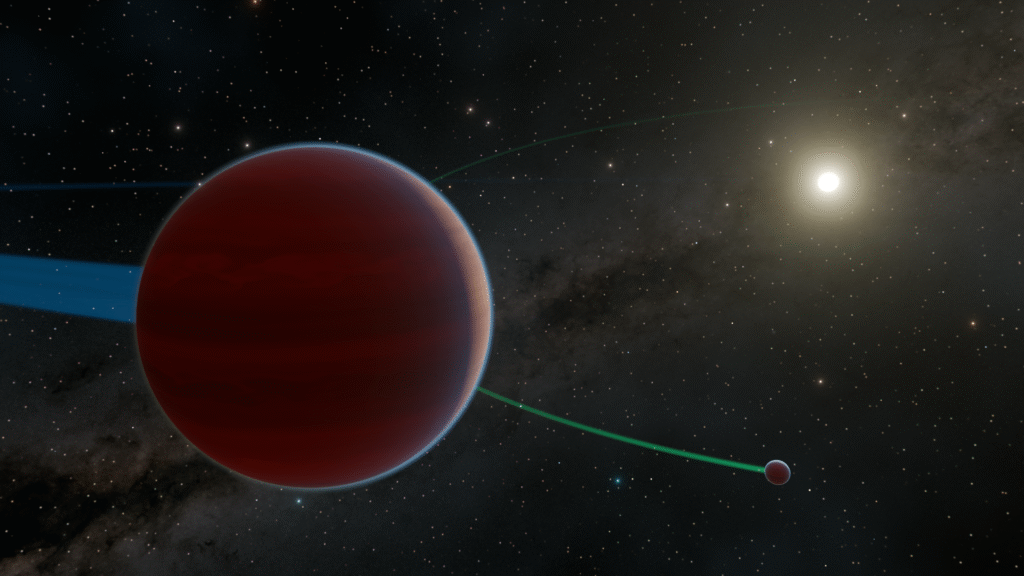
The KOI-134 Planetary System: A Unique Find
In a groundbreaking re-analysis of Kepler data, scientists have revealed the KOI-134 planetary system, a rare and dynamic star system that orbits like an old-fashioned merry-go-round. This discovery has rewritten the history of a star once thought to harbor no planets. Let’s dive into what makes the KOI-134 planetary system so fascinating.
Why the KOI-134 Planetary System Was Overlooked
Over a decade ago, NASA’s Kepler Space Telescope observed the star KOI-134 and noted irregular transits — the dips in brightness when a planet crosses its star. At the time, astronomers dismissed the candidate planet as a false positive because its transit times didn’t fit the expected pattern. But thanks to NASA’s policy of open data, researchers revisited the Kepler observations and uncovered the truth: the KOI-134 planetary system doesn’t just have one planet — it has two, orbiting in a unique cosmic dance.
Meet the Planets of the KOI-134 Planetary System
KOI-134 b: The Elusive Warm Jupiter
The first confirmed planet in the KOI-134 planetary system, KOI-134 b, is a warm Jupiter — a giant planet orbiting relatively close to its star. Its highly irregular transit timing — sometimes appearing as much as 20 hours early or late — baffled earlier astronomers. This phenomenon, called transit timing variation (TTV), happens because of the gravitational tug of another planet, which scientists have now identified.
KOI-134 c: The Hidden Saturn-like Companion
The second planet in the KOI-134 planetary system, KOI-134 c, is slightly smaller than Saturn and orbits on a tilted plane compared to KOI-134 b. This tilt — about 15 degrees — means it doesn’t pass in front of the star from our perspective, making it invisible to earlier observations. Only through detailed simulations and the detection of TTVs were scientists able to confirm its presence.
The KOI-134 Planetary System’s Merry-Go-Round Dynamics
The planets in this planetary system exhibit a mesmerizing orbital dance that has never been observed before. Their orbits aren’t flat but tilted relative to each other, and they resonate in a 2:1 rhythm — for every single orbit of KOI-134 b, KOI-134 c completes two orbits. Their mutual gravitational interactions cause their orbital planes to tilt back and forth over time, much like two ponies bobbing on a carousel.
Why the KOI-134 Matters
The KOI-134 planetary system is the first compact, multiplanet system discovered with such high mutual inclination, significant TTVs, and dynamic orbital tilts. Most planetary systems we know are relatively flat, making this discovery a rare opportunity to study how complex gravitational interactions can sculpt a planetary system.
Fun Facts About the KOI-134 Planetary System
- Originally marked as a false positive, the KOI-134 planetary system turned out to be a vibrant two-planet system.
- The mutual inclination of ~15 degrees between the planets is significant and rarely measured in close planetary pairs.
- The 2:1 resonance between the planets creates a predictable but unusual rhythm in their orbits.
The Team Behind the KOI-134 Planetary System Discovery
This exciting discovery was led by Emma Nabbie from the University of Southern Queensland. Her team’s paper, “A high mutual inclination system around KOI-134 revealed by transit timing variations,” published in Nature Astronomy on June 27, highlights the ingenuity of re-analyzing archival data. Collaborators hailed from the University of Geneva, University of La Laguna, Purple Mountain Observatory, Harvard-Smithsonian Center for Astrophysics, Georgia Institute of Technology, and NASA.
Conclusion: The KOI-134 Planetary System Redefines Our Understanding
The KOI-134 planetary system reminds us that space is full of surprises. What was once dismissed as noise in the data is now a case study in planetary dynamics. This discovery deepens our understanding of how planets interact, orbit, and evolve.
1 thought on “Discovery Alert: Unveiling the KOI-134 Planetary System — A Cosmic Carousel”